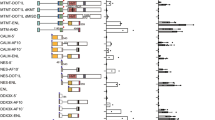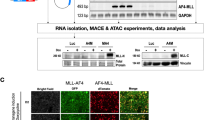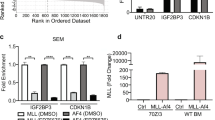Abstract
MLL/AF4 and AML/MTG8 represent two leukemic fusion genes, which are most frequently found in infant acute lymphoblastic leukemia (ALL) and acute myeloid leukemia (AML), respectively. We examined the influence of MLL/AF4 and AML1/MTG8 fusion genes on the expression of TERT coding for the telomerase protein subunit, and subsequently telomerase activity in t(4;11)-positive ALL and t(8;21)-positive cell lines, respectively. MLL/AF4 suppression diminished telomerase activity and expression of TERT. Blocking pro-apoptotic caspase activation in conjunction with MLL/AF4 knockdown enhanced the inhibition of TERT gene expression, which suggests that MLL/AF4 depletion does not reduce TERT expression levels by inducing apoptosis. Knockdown of HOXA7, a direct transcriptional target of MLL/AF4 fusion gene, caused a reduction of telomerase and TERT to an extent similar to that observed with MLL/AF4 suppression. Chromatin immunoprecipitation of SEM cells, using ectopically expressed FLAG-tagged Hoxa7, indicates HOXA7 binding site in the TERT promoter region. Furthermore, suppression of the AML1/MTG8 fusion gene was associated with severely reduced clonogenicity, induction of replicative senescence, impaired TERT expression and accelerated telomere shortening. We thus present findings that show a mechanistic link between leukemic fusion proteins, essential for development and maintenance of leukemia, and telomerase, a key element of both normal and malignant self-renewal.
This is a preview of subscription content, access via your institution
Access options
Subscribe to this journal
Receive 12 print issues and online access
$259.00 per year
only $21.58 per issue
Buy this article
- Purchase on Springer Link
- Instant access to full article PDF
Prices may be subject to local taxes which are calculated during checkout






Similar content being viewed by others
References
Dick JE . Stem cell concepts renew cancer research. Blood 2008; 112: 4793–4807.
Misaghian N, Ligresti G, Steelman LS, Bertrand FE, Basecke J, Libra M et al. Targeting the leukemic stem cell: the Holy Grail of leukemia therapy. Leukemia 2009; 23: 25–42.
Deng Y, Chan SS, Chang S . Telomere dysfunction and tumour suppression: the senescence connection. Nat Rev 2008; 8: 450–458.
Nakamura TM, Morin GB, Chapman KB, Weinrich SL, Andrews WH, Lingner J et al. Telomerase catalytic subunit homologs from fission yeast and human. Science 1997; 277: 955–959.
Lin SY, Elledge SJ . Multiple tumor suppressor pathways negatively regulate telomerase. Cell 2003; 113: 881–889.
Hrdlickova R, Nehyba J, Bose Jr HR . Regulation of telomerase activity by interferon regulatory factors 4 and 8 in immune cells. Mol Cell Biol 2009; 29: 929–941.
Gelmetti V, Zhang J, Fanelli M, Minucci S, Pelicci PG, Lazar MA . Aberrant recruitment of the nuclear receptor corepressor-histone deacetylase complex by the acute myeloid leukemia fusion partner ETO. Mol Cell Biol 1998; 18: 7185–7191.
Lutterbach B, Westendorf JJ, Linggi B, Patten A, Moniwa M, Davie JR et al. ETO, a target of t(8;21) in acute leukemia, interacts with the N-CoR and mSin3 corepressors. Mol Cell Biol 1998; 18: 7176–7184.
Peterson LF, Zhang DE . The 8;21 translocation in leukemogenesis. Oncogene 2004; 23: 4255–4262.
Gu Y, Nakamura T, Alder H, Prasad R, Canaani O, Cimino G et al. The t(4;11) chromosome translocation of human acute leukemias fuses the ALL-1 gene, related to Drosophila trithorax, to the AF-4 gene. Cell 1992; 71: 701–708.
Ziemin-van der Poel S, McCabe NR, Gill HJ, Espinosa III R, Patel Y, Harden A et al. Identification of a gene, MLL, that spans the breakpoint in 11q23 translocations associated with human leukemias. Proc Natl Acad Sci USA 1991; 88: 10735–10739.
Domer PH, Fakharzadeh SS, Chen CS, Jockel J, Johansen L, Silverman GA et al. Acute mixed-lineage leukemia t(4;11)(q21;q23) generates an MLL-AF4 fusion product. Proc Natl Acad Sci USA 1993; 90: 7884–7888.
Pui CH, Campana D . Age-related differences in leukemia biology and prognosis: the paradigm of MLL-AF4-positive acute lymphoblastic leukemia. Leukemia 2007; 21: 593–594.
Gale KB, Ford AM, Repp R, Borkhardt A, Keller C, Eden OB et al. Backtracking leukemia to birth: identification of clonotypic gene fusion sequences in neonatal blood spots. Proc Natl Acad Sci USA 1997; 94: 13950–13954.
Wiemels JL, Xiao Z, Buffler PA, Maia AT, Ma X, Dicks BM et al. In utero origin of t(8;21) AML1-ETO translocations in childhood acute myeloid leukemia. Blood 2002; 99: 3801–3805.
Krivtsov AV, Feng Z, Lemieux ME, Faber J, Vempati S, Sinha AU et al. H3K79 methylation profiles define murine and human MLL-AF4 leukemias. Cancer cell 2008; 14: 355–368.
Heidenreich O, Krauter J, Riehle H, Hadwiger P, John M, Heil G et al. AML1/MTG8 oncogene suppression by small interfering RNAs supports myeloid differentiation of t(8;21)-positive leukemic cells. Blood 2003; 101: 3157–3163.
Mulloy JC, Cammenga J, Berguido FJ, Wu K, Zhou P, Comenzo RL et al. Maintaining the self-renewal and differentiation potential of human CD34+ hematopoietic cells using a single genetic element. Blood 2003; 102: 4369–4376.
Thomas M, Gessner A, Vornlocher HP, Hadwiger P, Greil J, Heidenreich O . Targeting MLL-AF4 with short interfering RNAs inhibits clonogenicity and engraftment of t(4;11)-positive human leukemic cells. Blood 2005; 106: 3559–3566.
Muller-Tidow C, Steffen B, Cauvet T, Tickenbrock L, Ji P, Diederichs S et al. Translocation products in acute myeloid leukemia activate the Wnt signaling pathway in hematopoietic cells. Mol Cell Biol 2004; 24: 2890–2904.
Higuchi M, O'Brien D, Kumaravelu P, Lenny N, Yeoh EJ, Downing JR . Expression of a conditional AML1-ETO oncogene bypasses embryonic lethality and establishes a murine model of human t(8;21) acute myeloid leukemia. Cancer cell 2002; 1: 63–74.
Chen W, Li Q, Hudson WA, Kumar A, Kirchhof N, Kersey JH . A murine Mll-AF4 knock-in model results in lymphoid and myeloid deregulation and hematologic malignancy. Blood 2006; 108: 669–677.
Metzler M, Forster A, Pannell R, Arends MJ, Daser A, Lobato MN et al. A conditional model of MLL-AF4 B-cell tumourigenesis using invertor technology. Oncogene 2006; 25: 3093–3103.
Bursen A, Schwabe K, Ruster B, Henschler R, Ruthardt M, Dingermann T et al. The AF4.MLL fusion protein is capable of inducing ALL in mice without requirement of MLL.AF4. Blood 2010; 115: 3570–3579.
Guenther MG, Jenner RG, Chevalier B, Nakamura T, Croce CM, Canaani E et al. Global and Hox-specific roles for the MLL1 methyltransferase. Proc Natl Acad Sci USA 2005; 102: 8603–8608.
Guenther MG, Lawton LN, Rozovskaia T, Frampton GM, Levine SS, Volkert TL et al. Aberrant chromatin at genes encoding stem cell regulators in human mixed-lineage leukemia. Genes Dev 2008; 22: 3403–3408.
Faber J, Krivtsov AV, Stubbs MC, Wright R, Davis TN, van den Heuvel-Eibrink M et al. HOXA9 is required for survival in human MLL-rearranged acute leukemias. Blood 2009; 113: 2375–2385.
Greil J, Gramatzki M, Burger R, Marschalek R, Peltner M, Trautmann U et al. The acute lymphoblastic leukaemia cell line SEM with t(4;11) chromosomal rearrangement is biphenotypic and responsive to interleukin-7. Br J Haematol 1994; 86: 275–283.
Stong RC, Korsmeyer SJ, Parkin JL, Arthur DC, Kersey JH . Human acute leukemia cell line with the t(4;11) chromosomal rearrangement exhibits B lineage and monocytic characteristics. Blood 1985; 65: 21–31.
Lange B, Valtieri M, Santoli D, Caracciolo D, Mavilio F, Gemperlein I et al. Growth factor requirements of childhood acute leukemia: establishment of GM-CSF-dependent cell lines. Blood 1987; 70: 192–199.
Asou H, Tashiro S, Hamamoto K, Otsuji A, Kita K, Kamada N . Establishment of a human acute myeloid leukemia cell line (Kasumi-1) with 8;21 chromosome translocation. Blood 1991; 77: 2031–2036.
Matozaki S, Nakagawa T, Kawaguchi R, Aozaki R, Tsutsumi M, Murayama T et al. Establishment of a myeloid leukaemic cell line (SKNO-1) from a patient with t(8;21) who acquired monosomy 17 during disease progression. Br J Haematol 1995; 89: 805–811.
Martinez N, Drescher B, Riehle H, Cullmann C, Vornlocher HP, Ganser A et al. The oncogenic fusion protein RUNX1-CBFA2T1 supports proliferation and inhibits senescence in t(8;21)-positive leukaemic cells. BMC Cancer 2004; 4: 44.
Nakanishi H, Nakamura T, Canaani E, Croce CM . ALL1 fusion proteins induce deregulation of EphA7 and ERK phosphorylation in human acute leukemias. Proc Natl Acad Sci USA 2007; 104: 14442–14447.
Wege H, Chui MS, Le HT, Tran JM, Zern MA . SYBR Green real-time telomeric repeat amplification protocol for the rapid quantification of telomerase activity. Nucleic Acids Res 2003; 31: E3-3.
Baerlocher GM, Vulto I, de Jong G, Lansdorp PM . Flow cytometry and FISH to measure the average length of telomeres (flow FISH). Nat Protoc 2006; 1: 2365–2376.
Zeisig BB, Milne T, Garcia-Cuellar MP, Schreiner S, Martin ME, Fuchs U et al. Hoxa9 and Meis1 are key targets for MLL-ENL-mediated cellular immortalization. Mol Cell Biol 2004; 24: 617–628.
Nakajima A, Tauchi T, Sashida G, Sumi M, Abe K, Yamamoto K et al. Telomerase inhibition enhances apoptosis in human acute leukemia cells: possibility of antitelomerase therapy. Leukemia 2003; 17: 560–567.
Martinez Soria N, Tussiwand R, Ziegler P, Manz MG, Heidenreich O . Transient depletion of RUNX1/RUNX1T1 by RNA interference delays tumour formation in vivo. Leukemia 2009; 23: 188–190.
Hartmann U, Brummendorf TH, Balabanov S, Thiede C, Illme T, Schaich M . Telomere length and hTERT expression in patients with acute myeloid leukemia correlates with chromosomal abnormalities. Haematologica 2005; 90: 307–316.
Matsunobu T, Tanaka K, Nakamura T, Nakatani F, Sakimura R, Hanada M et al. The possible role of EWS-Fli1 in evasion of senescence in Ewing family tumors. Cancer Res 2006; 66: 803–811.
Takahashi A, Higashino F, Aoyagi M, Yoshida K, Itoh M, Kyo S et al. EWS/ETS fusions activate telomerase in Ewing's tumors. Cancer Res 2003; 63: 8338–8344.
Okada Y, Feng Q, Lin Y, Jiang Q, Li Y, Coffield VM et al. hDOT1L links histone methylation to leukemogenesis. Cell 2005; 121: 167–178.
Milne TA, Martin ME, Brock HW, Slany RK, Hess JL . Leukemogenic MLL fusion proteins bind across a broad region of the Hox a9 locus, promoting transcription and multiple histone modifications. Cancer Res 2005; 65: 11367–11374.
Li Z, Luo RT, Mi S, Sun M, Chen P, Bao J et al. Consistent deregulation of gene expression between human and murine MLL rearrangement leukemias. Cancer Res 2009; 69: 1109–1116.
Chen W, Kumar AR, Hudson WA, Li Q, Wu B, Staggs RA et al. Malignant transformation initiated by Mll-AF9: gene dosage and critical target cells. Cancer Cell 2008; 13: 432–440.
Krivtsov AV, Twomey D, Feng Z, Stubbs MC, Wang Y, Faber J et al. Transformation from committed progenitor to leukaemia stem cell initiated by MLL-AF9. Nature 2006; 442: 818–822.
Wei J, Wunderlich M, Fox C, Alvarez S, Cigudosa JC, Wilhelm JS et al. Microenvironment determines lineage fate in a human model of MLL-AF9 leukemia. Cancer Cell 2008; 13: 483–495.
Slany RK . The molecular biology of mixed lineage leukemia. Haematologica 2009; 94: 984–993.
Nakamura T, Largaespada DA, Shaughnessy Jr JD, Jenkins NA, Copeland NG . Cooperative activation of Hoxa and Pbx1-related genes in murine myeloid leukaemias. Nat Genet 1996; 12: 149–153.
Bei L, Lu Y, Bellis SL, Zhou W, Horvath E, Eklund EA . Identification of a HoxA10 activation domain necessary for transcription of the gene encoding beta3 integrin during myeloid differentiation. J Biol Chem 2007; 282: 16846–16859.
Hu YL, Passegue E, Fong S, Largman C, Lawrence HJ . Evidence that the Pim1 kinase gene is a direct target of HOXA9. Blood 2007; 109: 4732–4738.
Whelan JT, Ludwig DL, Bertrand FE . HoxA9 induces insulin-like growth factor-1 receptor expression in B-lineage acute lymphoblastic leukemia. Leukemia 2008; 22: 1161–1169.
La Celle PT, Polakowska RR . Human homeobox HOXA7 regulates keratinocyte transglutaminase type 1 and inhibits differentiation. J Biol Chem 2001; 276: 32844–32853.
Stam RW, Schneider P, Hagelstein JA, van der Linden MH, Stumpel DJ, de Menezes RX et al. Gene expression profiling-based dissection of MLL translocated and MLL germline acute lymphoblastic leukemia in infants. Blood 2009; 115: 2835–2844.
Trentin L, Giordan M, Dingermann T, Basso G, Te Kronnie G, Marschalek R . Two independent gene signatures in pediatric t(4;11) acute lymphoblastic leukemia patients. Eur J Haematol 2009; 83: 406–419.
Ross ME, Mahfouz R, Onciu M, Liu HC, Zhou X, Song G et al. Gene expression profiling of pediatric acute myelogenous leukemia. Blood 2004; 104: 3679–3687.
Gizard F, Nomiyama T, Zhao Y, Findeisen HM, Heywood EB, Jones KL et al. The PPARalpha/p16INK4a pathway inhibits vascular smooth muscle cell proliferation by repressing cell cycle-dependent telomerase activation. Circ Res 2008; 103: 1155–1163.
Rothdiener M, Muller D, Castro PG, Scholz A, Schwemmlein M, Fey G et al. Targeted delivery of SiRNA to CD33-positive tumor cells with liposomal carrier systems. J Control Release 2010; 144: 251–258.
Acknowledgements
This work was supported by grants from the Deutsche Jose Carreras Leukämie-Stiftung (DJCLS R 07/31f to JG and OH), the Northern England Children's Cancer Research Fund (to OH and JV), Leukaemia and Lymphoma Research (08011 to OH and JV) and the Kay Kendal Leukaemia Fund (KKL329 to OH and JV). AG, MT and PGC designed and performed research and analyzed data; LB, NMS, AS and TB performed research and analyzed data; JV and JG designed research and OH designed research, analyzed data and wrote the paper.
Author information
Authors and Affiliations
Corresponding author
Ethics declarations
Competing interests
The authors declare no conflict of interest.
Additional information
Supplementary Information accompanies the paper on the Leukemia website
Supplementary information
Rights and permissions
About this article
Cite this article
Gessner, A., Thomas, M., Garrido Castro, P. et al. Leukemic fusion genes MLL/AF4 and AML1/MTG8 support leukemic self-renewal by controlling expression of the telomerase subunit TERT. Leukemia 24, 1751–1759 (2010). https://doi.org/10.1038/leu.2010.155
Received:
Revised:
Accepted:
Published:
Issue Date:
DOI: https://doi.org/10.1038/leu.2010.155
Keywords
This article is cited by
-
Nanoparticle-mediated targeting of the fusion gene RUNX1/ETO in t(8;21)-positive acute myeloid leukaemia
Leukemia (2023)
-
A RUNX1/ETO-SKP2-CDKN1B axis regulates expression of telomerase in t (8;21) acute myeloid leukemia
Cellular and Molecular Life Sciences (2023)
-
Inhibition of Slug effectively targets leukemia stem cells via the Slc13a3/ROS signaling pathway
Leukemia (2020)
-
Crosstalk between 14-3-3θ and AF4 enhances MLL-AF4 activity and promotes leukemia cell proliferation
Cellular Oncology (2019)
-
The HDAC inhibitor panobinostat (LBH589) exerts in vivo anti-leukaemic activity against MLL-rearranged acute lymphoblastic leukaemia and involves the RNF20/RNF40/WAC-H2B ubiquitination axis
Leukemia (2018)



